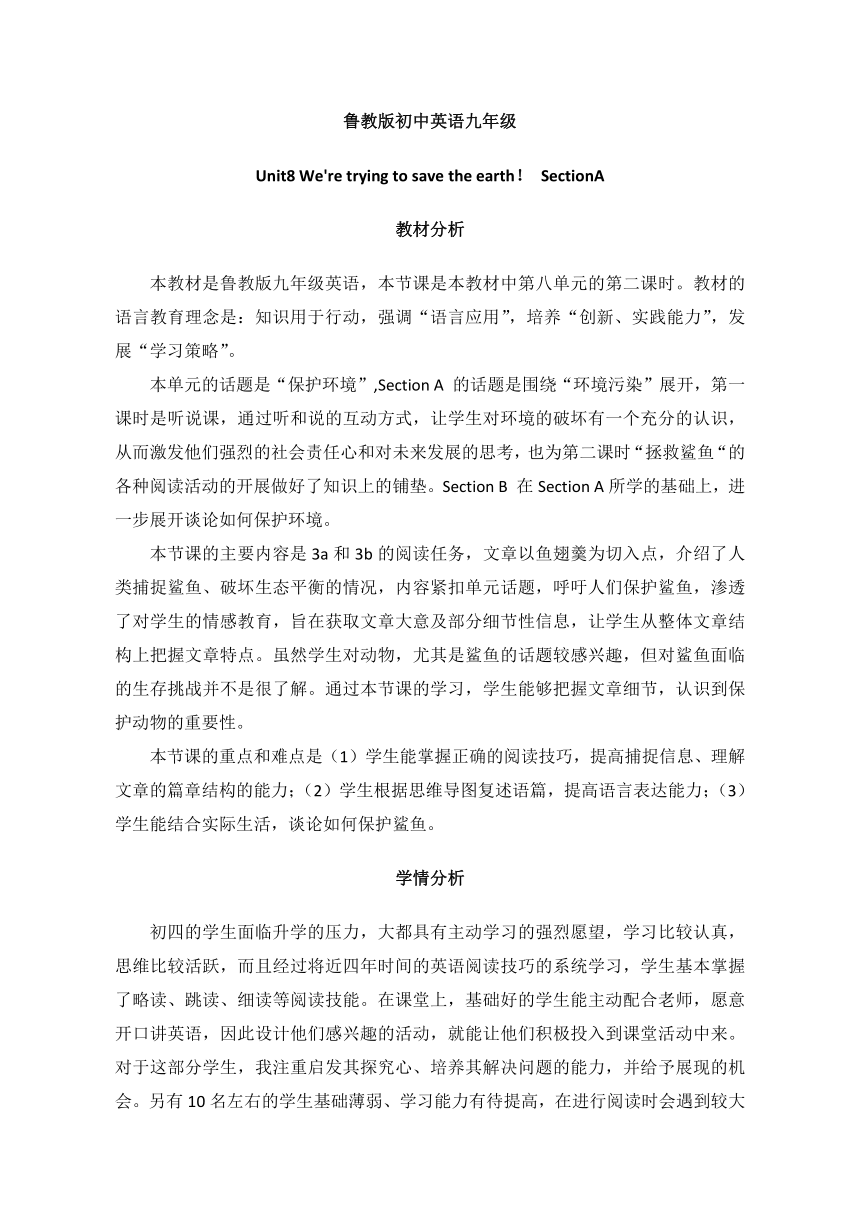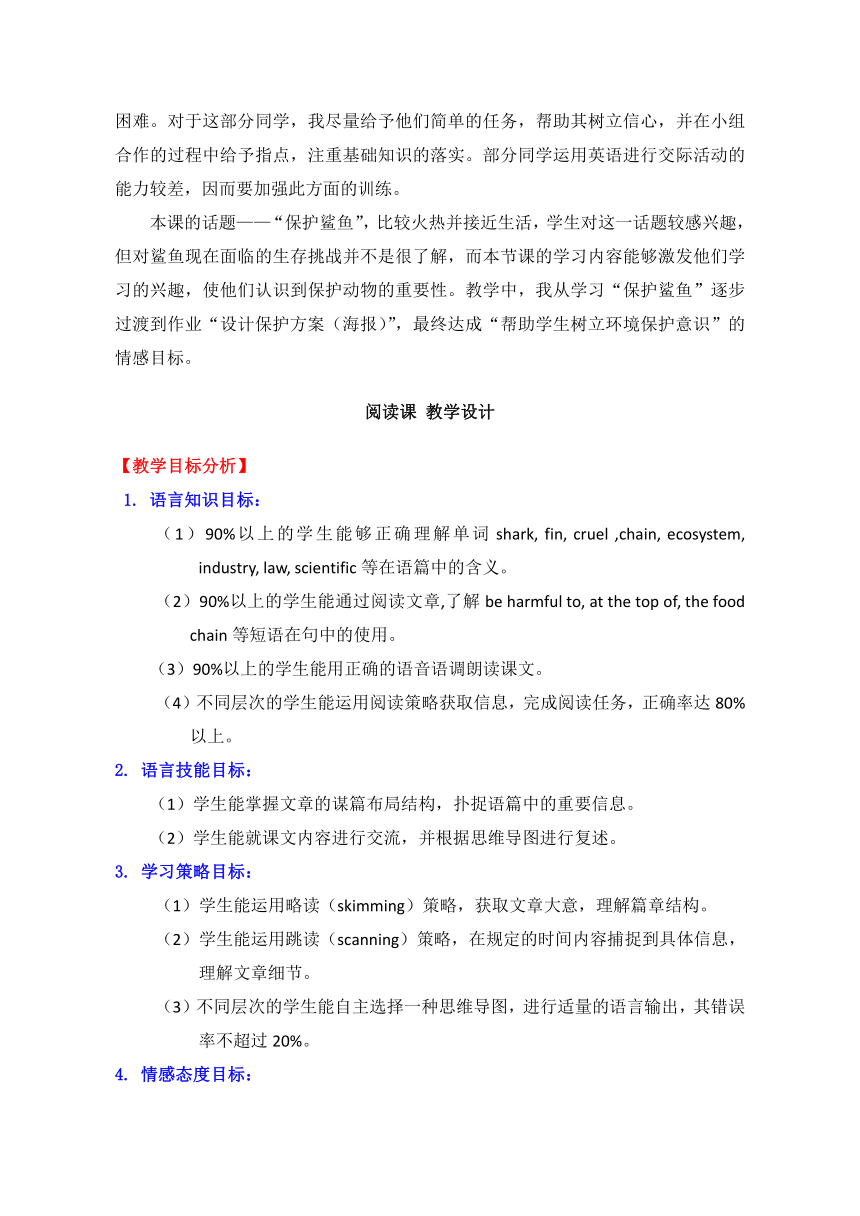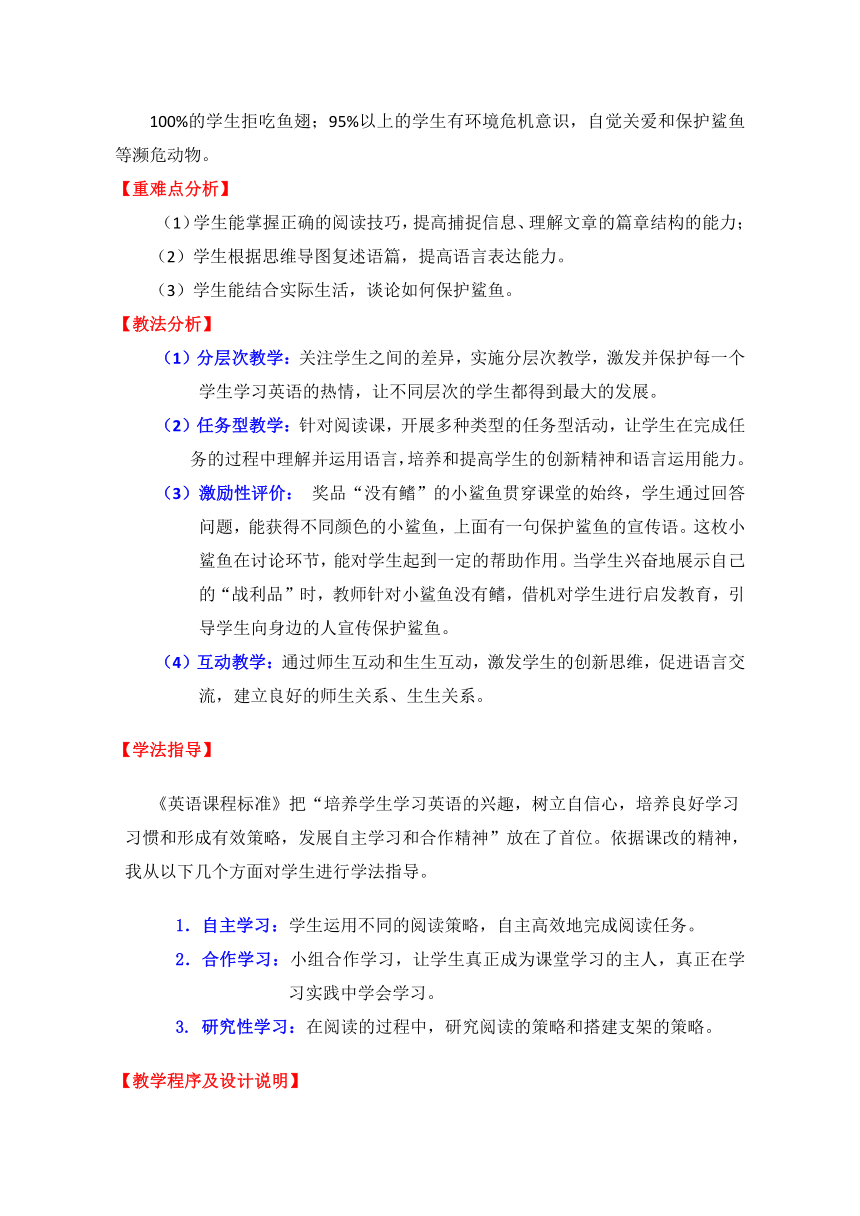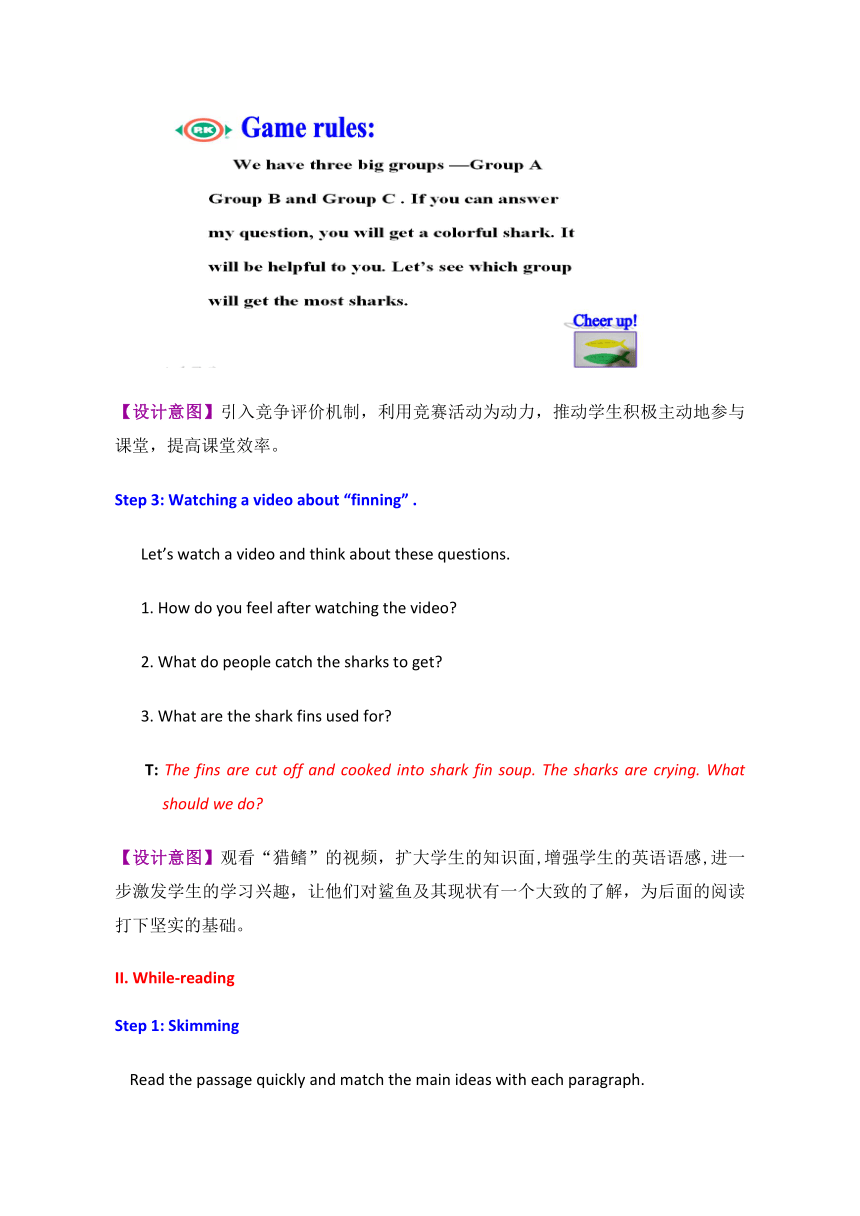鲁教(五四)版九年级全册 Unit 8 We're trying to save the earth!Section A 教案
文档属性
| 名称 | 鲁教(五四)版九年级全册 Unit 8 We're trying to save the earth!Section A 教案 |  | |
| 格式 | doc | ||
| 文件大小 | 2.1MB | ||
| 资源类型 | 教案 | ||
| 版本资源 | 鲁教版 | ||
| 科目 | 英语 | ||
| 更新时间 | 2022-10-12 10:11:07 | ||
图片预览





文档简介
鲁教版初中英语九年级
Unit8 We're trying to save the earth! SectionA
教材分析
本教材是鲁教版九年级英语,本节课是本教材中第八单元的第二课时。教材的语言教育理念是:知识用于行动,强调“语言应用”,培养“创新、实践能力”,发展“学习策略”。
本单元的话题是“保护环境”,Section A 的话题是围绕“环境污染”展开,第一课时是听说课,通过听和说的互动方式,让学生对环境的破坏有一个充分的认识,从而激发他们强烈的社会责任心和对未来发展的思考,也为第二课时“拯救鲨鱼“的各种阅读活动的开展做好了知识上的铺垫。Section B 在Section A所学的基础上,进一步展开谈论如何保护环境。
本节课的主要内容是3a和3b的阅读任务,文章以鱼翅羹为切入点,介绍了人类捕捉鲨鱼、破坏生态平衡的情况,内容紧扣单元话题,呼吁人们保护鲨鱼,渗透了对学生的情感教育,旨在获取文章大意及部分细节性信息,让学生从整体文章结构上把握文章特点。虽然学生对动物,尤其是鲨鱼的话题较感兴趣,但对鲨鱼面临的生存挑战并不是很了解。通过本节课的学习,学生能够把握文章细节,认识到保护动物的重要性。
本节课的重点和难点是(1)学生能掌握正确的阅读技巧,提高捕捉信息、理解文章的篇章结构的能力;(2)学生根据思维导图复述语篇,提高语言表达能力;(3)学生能结合实际生活,谈论如何保护鲨鱼。
学情分析
初四的学生面临升学的压力,大都具有主动学习的强烈愿望,学习比较认真,思维比较活跃,而且经过将近四年时间的英语阅读技巧的系统学习,学生基本掌握了略读、跳读、细读等阅读技能。在课堂上,基础好的学生能主动配合老师,愿意开口讲英语,因此设计他们感兴趣的活动,就能让他们积极投入到课堂活动中来。对于这部分学生,我注重启发其探究心、培养其解决问题的能力,并给予展现的机会。另有10名左右的学生基础薄弱、学习能力有待提高,在进行阅读时会遇到较大困难。对于这部分同学,我尽量给予他们简单的任务,帮助其树立信心,并在小组合作的过程中给予指点,注重基础知识的落实。部分同学运用英语进行交际活动的能力较差,因而要加强此方面的训练。
本课的话题——“保护鲨鱼”,比较火热并接近生活,学生对这一话题较感兴趣,但对鲨鱼现在面临的生存挑战并不是很了解,而本节课的学习内容能够激发他们学习的兴趣,使他们认识到保护动物的重要性。教学中,我从学习“保护鲨鱼”逐步过渡到作业“设计保护方案(海报)”,最终达成“帮助学生树立环境保护意识”的情感目标。
阅读课 教学设计
【教学目标分析】
1. 语言知识目标:
(1)90%以上的学生能够正确理解单词shark, fin, cruel ,chain, ecosystem, industry, law, scientific等在语篇中的含义。
(2)90%以上的学生能通过阅读文章,了解be harmful to, at the top of, the food chain等短语在句中的使用。
(3)90%以上的学生能用正确的语音语调朗读课文。
(4)不同层次的学生能运用阅读策略获取信息,完成阅读任务,正确率达80%以上。
2. 语言技能目标:
(1)学生能掌握文章的谋篇布局结构,扑捉语篇中的重要信息。
(2)学生能就课文内容进行交流,并根据思维导图进行复述。
3. 学习策略目标:
(1)学生能运用略读(skimming)策略,获取文章大意,理解篇章结构。
(2)学生能运用跳读(scanning)策略,在规定的时间内容捕捉到具体信息,理解文章细节。
(3)不同层次的学生能自主选择一种思维导图,进行适量的语言输出,其错误率不超过20%。
4. 情感态度目标:
100%的学生拒吃鱼翅;95%以上的学生有环境危机意识,自觉关爱和保护鲨鱼等濒危动物。
【重难点分析】
(1)学生能掌握正确的阅读技巧,提高捕捉信息、理解文章的篇章结构的能力;
(2)学生根据思维导图复述语篇,提高语言表达能力。
(3)学生能结合实际生活,谈论如何保护鲨鱼。
【教法分析】
(1)分层次教学:关注学生之间的差异,实施分层次教学,激发并保护每一个学生学习英语的热情,让不同层次的学生都得到最大的发展。
(2)任务型教学:针对阅读课,开展多种类型的任务型活动,让学生在完成任务的过程中理解并运用语言,培养和提高学生的创新精神和语言运用能力。
(3)激励性评价: 奖品“没有鳍”的小鲨鱼贯穿课堂的始终,学生通过回答问题,能获得不同颜色的小鲨鱼,上面有一句保护鲨鱼的宣传语。这枚小鲨鱼在讨论环节,能对学生起到一定的帮助作用。当学生兴奋地展示自己的“战利品”时,教师针对小鲨鱼没有鳍,借机对学生进行启发教育,引导学生向身边的人宣传保护鲨鱼。
(4)互动教学:通过师生互动和生生互动,激发学生的创新思维,促进语言交流,建立良好的师生关系、生生关系。
【学法指导】
《英语课程标准》把“培养学生学习英语的兴趣,树立自信心,培养良好学习习惯和形成有效策略,发展自主学习和合作精神”放在了首位。依据课改的精神,我从以下几个方面对学生进行学法指导。
1.自主学习:学生运用不同的阅读策略,自主高效地完成阅读任务。
2.合作学习:小组合作学习,让学生真正成为课堂学习的主人,真正在学习实践中学会学习。
3. 研究性学习:在阅读的过程中,研究阅读的策略和搭建支架的策略。
【教学程序及设计说明】
I. Pre-reading
Step 1: Leading in
T: Welcome to our English class. Please look! What can you see
S:Shark
T: Only letters What does it look like
S: A shark / A fish / The shape……
T: The shape is a shark. Do you like the shark
This class we are going to learn Unit 8 Save the Sharks !
【设计意图】教师通过展示“一条形象的、可爱的、由字母组成的鲨鱼缓缓向前游动”,抓住学生的眼球,勾起学生的好奇心,开门见山地导入本节课。
Step2: Learning about the game rules.
【设计意图】引入竞争评价机制,利用竞赛活动为动力,推动学生积极主动地参与课堂,提高课堂效率。
Step 3: Watching a video about “finning” .
Let’s watch a video and think about these questions.
1. How do you feel after watching the video
2. What do people catch the sharks to get
3. What are the shark fins used for
T: The fins are cut off and cooked into shark fin soup. The sharks are crying. What should we do
【设计意图】观看“猎鳍”的视频,扩大学生的知识面,增强学生的英语语感,进一步激发学生的学习兴趣,让他们对鲨鱼及其现状有一个大致的了解,为后面的阅读打下坚实的基础。
II. While-reading
Step 1: Skimming
Read the passage quickly and match the main ideas with each paragraph.
T: There are three parts: shark fin soup、people’s killing and protection groups. But how is shark fin soup How do the fishermen kill the sharks How do people save them Do you want to know Let’s go on.
【设计意图】学生略读文章,了解大意,理解篇章结构。
Step 2: Scanning
★★Task1: Read Paragraph 1 and fill in the blanks.
1. Show the answers and read together.
2. Ask one student to describe the picture. And lead them to draw the following conclusions.
A bowl of shark fin soup is the life of a whole shark.
Shark fin soup is murder. 鱼翅羹与谋杀无异。
T: How are the sharks killed What is the status of the sharks Let’s go on.
【设计意图】本环节学生运用扫读策略,更深层次地了解文章内容,降低了难度,为复述做好准备。在核对答案的过程中,追问学生对文章内容的理解情况,让学生深刻理解A bowl of shark fin soup is the life of a whole shark. Shark fin soup is murder.
★★Task2: Read Paragraph 2 and answer the questions.
1. How do people deal with sharks when they catch them
T: Ask one student to tell us his answers. And then ask him to describe the two pictures.
★Tell the students :This is called “finning”.
★Then ask the students : How do you like “finning”
★ Go on asking the students: What does the writer think of “finning “
2. What does the writer think of killing sharks
★Ask one student to tell us the answer: It is not only cruel but also harmful to the environment.
★Tell them : It means Finning.
Finning is not only cruel but also harmful to the environment.
★Ask the students:
Why is it cruel
Why is it harmful to the environment
S: Go on looking for these answers.
★Ask two students to show the answers. And then read together.
★If sharks’ numbers drop too low, it will bring danger to all ocean life. Why
T: Please look at the picture. What is this
S: The food chain.
T: What is at the top of the food chain in the ocean’s ecosystem
S: Sharks are at the top of the food chain in the ocean’s ecosystem.
T: Who is the real king of the food chain
S: Human beings are the real king of the food chain.
T: so saving sharks is saving ourselves. However, some people don’t think so. Every year, many sharks are caught and traded. How many
3. How many sharks are caught and traded every year
4. How much have the numbers of some kinds of sharks fallen in the last 20 to 30 years
T: Read these answers by yourself. And then retell together from 2 to 4 according to the following mind-map.
T:There are two numbers : 70 million and 90 percent. When you hear these numbers, how do you feel
S: ……
T: They make us surprised. Luckily, human beings have realized the importance of saving the sharks. What have they done
【设计意图】本环节通过设置不同梯度的问题,引领学生进一步了解“猎鳍”的过程以及鲨鱼面临的濒危现状。在核对答案过程中,对学生进行四次追问:一是学生对“猎鳍”的看法,并引出作者的看法;二是为什么说“猎鳍”是残忍的?三是为什么说“猎鳍”对环境有害?运用食物链,引导学生深入理解鲨鱼在整个生态系统中的重要作用,得出“拯救鲨鱼就是拯救我们自己”的结论;四是追问学生听到两组数字(70 million and 90 percent)时的感受。教师结合实际情况恰当地进行引导,适当地进行解释,帮助学生解决重点和难点。
★★Task3: Read Paragraph 3 and fill in the chart.
Ask one student to show his answers. And then the teacher leads the students to readg.
T: What are the two environmental protection groups
S:……
T: What are they doing
S: ……
Retell the fifth part together according to the mind-map.
T: We have grasped the main information .Now it’s our reading time.
【设计意图】本环节学生通过填写表格,了解人类为拯救鲨鱼所做出的努力,为复述做好准备。
III. Post-reading
Step 1: Reading aloud.
【设计意图】本环节学生通过反复的朗读,进行有效的语言输入,为下一环节的语言输出做好准备。
Step 2: Retelling.
T: It’s time to retell. There are two tasks. You may choose one of them.
At first, give them an example— task A.
Then retell the passage in groups.
At last, ask two groups to retell Task A and one group to retell Task B.
【设计意图】通过前面的略读、扫读和朗读,学生有了充分的语言知识储备。为了照顾学生之间的差异,教师在复述环节,设计了分层次复述篇章内容。学生可以自主选择一种思维导图,并在其引领下,轻松的完成复述任务,提高口语表达能力。
Step 3: Thinking :
The teacher inspires the students to think about the following questions.
【设计意图】本环节是在复述的基础上,对学生进行了两次追问:鱼翅对健康没有好处,人们还要吃鲨鱼的原因以及作者写这篇文章的意图。引导学生畅所欲言,最后得出结论:“请客吃饭上鱼翅”在多数人看来是高档消费的象征,能吃上鱼翅是一种身份和成功的标志。事实上,没有科学研究证明鱼翅对健康有好处,所以作者写作的目的正是为了呼吁人们拒吃鱼翅,拯救鲨鱼,进而引出下一环节的讨论“我们该如何保护鲨鱼”这一话题。
Step 4: Discussing in groups.
T: The writer wrote the passage to help save the sharks. Because sharks are endangered. Luckily, human beings are trying to save them. What about us How should we protect the sharks
1. Discuss the question in groups with the help of their prizes--- the colorful sharks.
2. And ask three students to share their advice.
3. Put up their prizes and see which group is the winner.
T: Congratulate! Unluckily, the sharks have no fins. They are crying. I think we should help the poor sharks. We may make more paper sharks with some sayings on them. We may give them to our parents, friends, relatives and people around us. And ask them not to eat shark fin. I believe you can do it best.
【设计意图】本环节的设置旨在让学生由课本回归现实,小组交流探讨“如何拯救鲨鱼”, 培养他们保护动物的意识以及对社会的责任感。。在讨论的过程,学生相互学习,相互影响,拓展了文章的主题,对文本的内涵进行了深层次的挖掘,从而在情感上得到进一步的升华,达到学以致用的目的。此时,学生在悄无声息中获得的奖品---“无鳍”的小鲨鱼也浮出了水面,每张鲨鱼上面的宣传语对学生的讨论起到了一定的作用。教师在学生展示自己的奖品时,又不失时机地利用“无鳍”的鲨鱼引导、教育学生宣传和拯救鲨鱼。
Step 5: Sharing something important with you.
T: At the end of this class, I’d like to share something important with you along with music.
【设计意图】再次对本节课的话题进行点睛,将情感教育进行升华。
Unit8 We're trying to save the earth! SectionA
教材分析
本教材是鲁教版九年级英语,本节课是本教材中第八单元的第二课时。教材的语言教育理念是:知识用于行动,强调“语言应用”,培养“创新、实践能力”,发展“学习策略”。
本单元的话题是“保护环境”,Section A 的话题是围绕“环境污染”展开,第一课时是听说课,通过听和说的互动方式,让学生对环境的破坏有一个充分的认识,从而激发他们强烈的社会责任心和对未来发展的思考,也为第二课时“拯救鲨鱼“的各种阅读活动的开展做好了知识上的铺垫。Section B 在Section A所学的基础上,进一步展开谈论如何保护环境。
本节课的主要内容是3a和3b的阅读任务,文章以鱼翅羹为切入点,介绍了人类捕捉鲨鱼、破坏生态平衡的情况,内容紧扣单元话题,呼吁人们保护鲨鱼,渗透了对学生的情感教育,旨在获取文章大意及部分细节性信息,让学生从整体文章结构上把握文章特点。虽然学生对动物,尤其是鲨鱼的话题较感兴趣,但对鲨鱼面临的生存挑战并不是很了解。通过本节课的学习,学生能够把握文章细节,认识到保护动物的重要性。
本节课的重点和难点是(1)学生能掌握正确的阅读技巧,提高捕捉信息、理解文章的篇章结构的能力;(2)学生根据思维导图复述语篇,提高语言表达能力;(3)学生能结合实际生活,谈论如何保护鲨鱼。
学情分析
初四的学生面临升学的压力,大都具有主动学习的强烈愿望,学习比较认真,思维比较活跃,而且经过将近四年时间的英语阅读技巧的系统学习,学生基本掌握了略读、跳读、细读等阅读技能。在课堂上,基础好的学生能主动配合老师,愿意开口讲英语,因此设计他们感兴趣的活动,就能让他们积极投入到课堂活动中来。对于这部分学生,我注重启发其探究心、培养其解决问题的能力,并给予展现的机会。另有10名左右的学生基础薄弱、学习能力有待提高,在进行阅读时会遇到较大困难。对于这部分同学,我尽量给予他们简单的任务,帮助其树立信心,并在小组合作的过程中给予指点,注重基础知识的落实。部分同学运用英语进行交际活动的能力较差,因而要加强此方面的训练。
本课的话题——“保护鲨鱼”,比较火热并接近生活,学生对这一话题较感兴趣,但对鲨鱼现在面临的生存挑战并不是很了解,而本节课的学习内容能够激发他们学习的兴趣,使他们认识到保护动物的重要性。教学中,我从学习“保护鲨鱼”逐步过渡到作业“设计保护方案(海报)”,最终达成“帮助学生树立环境保护意识”的情感目标。
阅读课 教学设计
【教学目标分析】
1. 语言知识目标:
(1)90%以上的学生能够正确理解单词shark, fin, cruel ,chain, ecosystem, industry, law, scientific等在语篇中的含义。
(2)90%以上的学生能通过阅读文章,了解be harmful to, at the top of, the food chain等短语在句中的使用。
(3)90%以上的学生能用正确的语音语调朗读课文。
(4)不同层次的学生能运用阅读策略获取信息,完成阅读任务,正确率达80%以上。
2. 语言技能目标:
(1)学生能掌握文章的谋篇布局结构,扑捉语篇中的重要信息。
(2)学生能就课文内容进行交流,并根据思维导图进行复述。
3. 学习策略目标:
(1)学生能运用略读(skimming)策略,获取文章大意,理解篇章结构。
(2)学生能运用跳读(scanning)策略,在规定的时间内容捕捉到具体信息,理解文章细节。
(3)不同层次的学生能自主选择一种思维导图,进行适量的语言输出,其错误率不超过20%。
4. 情感态度目标:
100%的学生拒吃鱼翅;95%以上的学生有环境危机意识,自觉关爱和保护鲨鱼等濒危动物。
【重难点分析】
(1)学生能掌握正确的阅读技巧,提高捕捉信息、理解文章的篇章结构的能力;
(2)学生根据思维导图复述语篇,提高语言表达能力。
(3)学生能结合实际生活,谈论如何保护鲨鱼。
【教法分析】
(1)分层次教学:关注学生之间的差异,实施分层次教学,激发并保护每一个学生学习英语的热情,让不同层次的学生都得到最大的发展。
(2)任务型教学:针对阅读课,开展多种类型的任务型活动,让学生在完成任务的过程中理解并运用语言,培养和提高学生的创新精神和语言运用能力。
(3)激励性评价: 奖品“没有鳍”的小鲨鱼贯穿课堂的始终,学生通过回答问题,能获得不同颜色的小鲨鱼,上面有一句保护鲨鱼的宣传语。这枚小鲨鱼在讨论环节,能对学生起到一定的帮助作用。当学生兴奋地展示自己的“战利品”时,教师针对小鲨鱼没有鳍,借机对学生进行启发教育,引导学生向身边的人宣传保护鲨鱼。
(4)互动教学:通过师生互动和生生互动,激发学生的创新思维,促进语言交流,建立良好的师生关系、生生关系。
【学法指导】
《英语课程标准》把“培养学生学习英语的兴趣,树立自信心,培养良好学习习惯和形成有效策略,发展自主学习和合作精神”放在了首位。依据课改的精神,我从以下几个方面对学生进行学法指导。
1.自主学习:学生运用不同的阅读策略,自主高效地完成阅读任务。
2.合作学习:小组合作学习,让学生真正成为课堂学习的主人,真正在学习实践中学会学习。
3. 研究性学习:在阅读的过程中,研究阅读的策略和搭建支架的策略。
【教学程序及设计说明】
I. Pre-reading
Step 1: Leading in
T: Welcome to our English class. Please look! What can you see
S:Shark
T: Only letters What does it look like
S: A shark / A fish / The shape……
T: The shape is a shark. Do you like the shark
This class we are going to learn Unit 8 Save the Sharks !
【设计意图】教师通过展示“一条形象的、可爱的、由字母组成的鲨鱼缓缓向前游动”,抓住学生的眼球,勾起学生的好奇心,开门见山地导入本节课。
Step2: Learning about the game rules.
【设计意图】引入竞争评价机制,利用竞赛活动为动力,推动学生积极主动地参与课堂,提高课堂效率。
Step 3: Watching a video about “finning” .
Let’s watch a video and think about these questions.
1. How do you feel after watching the video
2. What do people catch the sharks to get
3. What are the shark fins used for
T: The fins are cut off and cooked into shark fin soup. The sharks are crying. What should we do
【设计意图】观看“猎鳍”的视频,扩大学生的知识面,增强学生的英语语感,进一步激发学生的学习兴趣,让他们对鲨鱼及其现状有一个大致的了解,为后面的阅读打下坚实的基础。
II. While-reading
Step 1: Skimming
Read the passage quickly and match the main ideas with each paragraph.
T: There are three parts: shark fin soup、people’s killing and protection groups. But how is shark fin soup How do the fishermen kill the sharks How do people save them Do you want to know Let’s go on.
【设计意图】学生略读文章,了解大意,理解篇章结构。
Step 2: Scanning
★★Task1: Read Paragraph 1 and fill in the blanks.
1. Show the answers and read together.
2. Ask one student to describe the picture. And lead them to draw the following conclusions.
A bowl of shark fin soup is the life of a whole shark.
Shark fin soup is murder. 鱼翅羹与谋杀无异。
T: How are the sharks killed What is the status of the sharks Let’s go on.
【设计意图】本环节学生运用扫读策略,更深层次地了解文章内容,降低了难度,为复述做好准备。在核对答案的过程中,追问学生对文章内容的理解情况,让学生深刻理解A bowl of shark fin soup is the life of a whole shark. Shark fin soup is murder.
★★Task2: Read Paragraph 2 and answer the questions.
1. How do people deal with sharks when they catch them
T: Ask one student to tell us his answers. And then ask him to describe the two pictures.
★Tell the students :This is called “finning”.
★Then ask the students : How do you like “finning”
★ Go on asking the students: What does the writer think of “finning “
2. What does the writer think of killing sharks
★Ask one student to tell us the answer: It is not only cruel but also harmful to the environment.
★Tell them : It means Finning.
Finning is not only cruel but also harmful to the environment.
★Ask the students:
Why is it cruel
Why is it harmful to the environment
S: Go on looking for these answers.
★Ask two students to show the answers. And then read together.
★If sharks’ numbers drop too low, it will bring danger to all ocean life. Why
T: Please look at the picture. What is this
S: The food chain.
T: What is at the top of the food chain in the ocean’s ecosystem
S: Sharks are at the top of the food chain in the ocean’s ecosystem.
T: Who is the real king of the food chain
S: Human beings are the real king of the food chain.
T: so saving sharks is saving ourselves. However, some people don’t think so. Every year, many sharks are caught and traded. How many
3. How many sharks are caught and traded every year
4. How much have the numbers of some kinds of sharks fallen in the last 20 to 30 years
T: Read these answers by yourself. And then retell together from 2 to 4 according to the following mind-map.
T:There are two numbers : 70 million and 90 percent. When you hear these numbers, how do you feel
S: ……
T: They make us surprised. Luckily, human beings have realized the importance of saving the sharks. What have they done
【设计意图】本环节通过设置不同梯度的问题,引领学生进一步了解“猎鳍”的过程以及鲨鱼面临的濒危现状。在核对答案过程中,对学生进行四次追问:一是学生对“猎鳍”的看法,并引出作者的看法;二是为什么说“猎鳍”是残忍的?三是为什么说“猎鳍”对环境有害?运用食物链,引导学生深入理解鲨鱼在整个生态系统中的重要作用,得出“拯救鲨鱼就是拯救我们自己”的结论;四是追问学生听到两组数字(70 million and 90 percent)时的感受。教师结合实际情况恰当地进行引导,适当地进行解释,帮助学生解决重点和难点。
★★Task3: Read Paragraph 3 and fill in the chart.
Ask one student to show his answers. And then the teacher leads the students to readg.
T: What are the two environmental protection groups
S:……
T: What are they doing
S: ……
Retell the fifth part together according to the mind-map.
T: We have grasped the main information .Now it’s our reading time.
【设计意图】本环节学生通过填写表格,了解人类为拯救鲨鱼所做出的努力,为复述做好准备。
III. Post-reading
Step 1: Reading aloud.
【设计意图】本环节学生通过反复的朗读,进行有效的语言输入,为下一环节的语言输出做好准备。
Step 2: Retelling.
T: It’s time to retell. There are two tasks. You may choose one of them.
At first, give them an example— task A.
Then retell the passage in groups.
At last, ask two groups to retell Task A and one group to retell Task B.
【设计意图】通过前面的略读、扫读和朗读,学生有了充分的语言知识储备。为了照顾学生之间的差异,教师在复述环节,设计了分层次复述篇章内容。学生可以自主选择一种思维导图,并在其引领下,轻松的完成复述任务,提高口语表达能力。
Step 3: Thinking :
The teacher inspires the students to think about the following questions.
【设计意图】本环节是在复述的基础上,对学生进行了两次追问:鱼翅对健康没有好处,人们还要吃鲨鱼的原因以及作者写这篇文章的意图。引导学生畅所欲言,最后得出结论:“请客吃饭上鱼翅”在多数人看来是高档消费的象征,能吃上鱼翅是一种身份和成功的标志。事实上,没有科学研究证明鱼翅对健康有好处,所以作者写作的目的正是为了呼吁人们拒吃鱼翅,拯救鲨鱼,进而引出下一环节的讨论“我们该如何保护鲨鱼”这一话题。
Step 4: Discussing in groups.
T: The writer wrote the passage to help save the sharks. Because sharks are endangered. Luckily, human beings are trying to save them. What about us How should we protect the sharks
1. Discuss the question in groups with the help of their prizes--- the colorful sharks.
2. And ask three students to share their advice.
3. Put up their prizes and see which group is the winner.
T: Congratulate! Unluckily, the sharks have no fins. They are crying. I think we should help the poor sharks. We may make more paper sharks with some sayings on them. We may give them to our parents, friends, relatives and people around us. And ask them not to eat shark fin. I believe you can do it best.
【设计意图】本环节的设置旨在让学生由课本回归现实,小组交流探讨“如何拯救鲨鱼”, 培养他们保护动物的意识以及对社会的责任感。。在讨论的过程,学生相互学习,相互影响,拓展了文章的主题,对文本的内涵进行了深层次的挖掘,从而在情感上得到进一步的升华,达到学以致用的目的。此时,学生在悄无声息中获得的奖品---“无鳍”的小鲨鱼也浮出了水面,每张鲨鱼上面的宣传语对学生的讨论起到了一定的作用。教师在学生展示自己的奖品时,又不失时机地利用“无鳍”的鲨鱼引导、教育学生宣传和拯救鲨鱼。
Step 5: Sharing something important with you.
T: At the end of this class, I’d like to share something important with you along with music.
【设计意图】再次对本节课的话题进行点睛,将情感教育进行升华。
同课章节目录
- Unit 1 When was it invented?
- Section A
- Section B
- Unit 2 Teenagers should be allowed to choose their
- Section A
- Section B
- Unit 3 It must belong to Carla.
- Section A
- Section B
- Unit 4 I like music that I can dance to.
- Section A
- Section B
- Unit 5 You’re supposed to shake hands.
- Section A
- Section B
- Unit 6 Sad movies make me cry.
- Section A
- Section B
- Unit 7 Life is full of the unexpected.
- Section A
- Section B
- Unit 8 We're trying to save the earth!
- Section A
- Section B
- Unit 9 It's important to have good habits.
- Section A
- Section B
- Unit 10 I remember meeting all of you in Grade 6.
- Section A
- Section B
